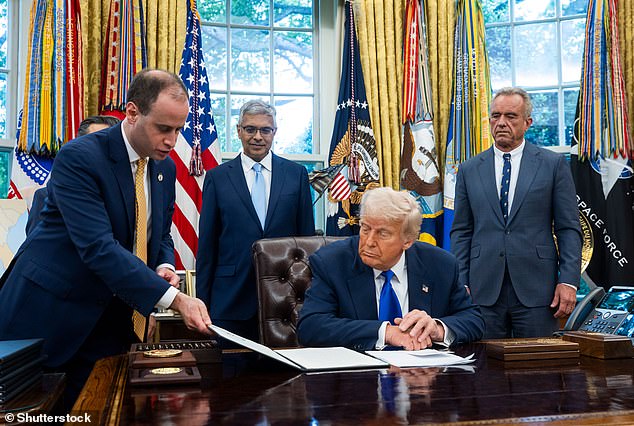Many celebrated when President Donald Trump signed a new executive order this week restricting research that could trigger the next pandemic.
The order banned US funds from being used to sponsor research abroad known as ‘gain-of-function’, when pathogens are deliberately made more infectious or deadly.
‘It’s a big deal’, said the President, while putting pen to paper in a White House briefing Monday, ‘It could have been that we wouldn’t have had the problem we had if we had this done earlier’.
But a closer look at the fine-print of the order suggests it does not go as far as the full-scale ban on the research that many had hoped for.
Trump’s executive only bans federal funds from being used in ‘countries of concern’ like China and Iran. In the US and other allied countries, it allows federal funding of the work to continue — but proposes more monitoring from the US government.
Thomas Renz, a vaccine-skeptic lawyer and supporter of Trump, claims the new policy doesn’t end gain-of-function. He says it ‘codifies it.’
He told The Daily Pulse: ‘They’re going to allow it under new regulations. And by doing that, they’re essentially saying, “We’re fine with gain-of-function as long as it follows the current rules.”
‘So in that way, they’re actually legitimizing gain-of-function work in this country, which is absolutely mind-blowing to me,’ he added.

Donald Trump is pictured above preparing to sign the executive order on gain-of-function research. He is flanked by his secretary for health Robert F. Kennedy Junior, the head of the NIH, Dr Jay Bhattacharya, and the head of the Centers for Medicare and Medicaid Services, Dr Mehmet Oz. White House Secretary Will Scharf is shown handing the President the order
Trump signed the executive order in a 20-minute session in the White House Monday flanked by the HHS secretary as well as the head of the NIH, Dr Jay Bhattacharya and the head of the Centers for Medicare and Medicaid, Dr Mehmet Oz.
A copy of the order posted online reads: ‘The Biden Administration allowed dangerous gain-of-function research within the United States with insufficient levels of oversight.
‘It also actively approved, through the National Institutes of Health, Federal life-science research funding in China and other countries where there is limited United States oversight or reasonable expectation of biosafety enforcement.’
It continued: ‘This recklessness, if unaddressed, may lead to the proliferation of research on pathogens (and potential pathogens) in settings without adequate safeguards, even after Covid-19 revealed the risk of such practices.’
It also asks the head of the Office of Science and Technology Policy, Michael Kratsios, to come up with new guidelines for monitoring the research in the next 120 days.
In 2014 under the Obama administration, all federal funding on experiments that could make certain viruses more dangerous was halted.
Trump reversed this ban in 2017, allowing the experiments to continue — although under a very tight framework.
After the Covid pandemic, however, last year the Biden administration brought in a sweeping set of federal laws for monitoring the research.
The new order seeks to build on this Biden era framework, and come up with a new method for monitoring the experiments.
Biden’s move has already faced criticism for failing to set up an independent federal agency to monitor the research.
This article was originally published by a www.dailymail.co.uk . Read the Original article here. .

